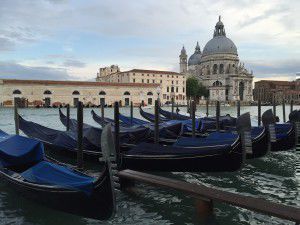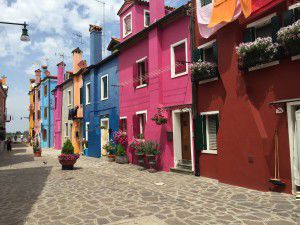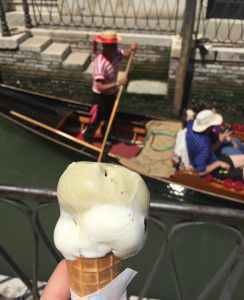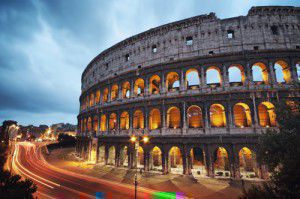5 times you spoke Italian and didn’t know it
Did you know that you speak Italian?
No, really – you do. And we don’t just mean that time you ordered a pizza. Here are a few words you’ve probably used at some point, but might not have realised were Italian:
Novella
Longer than a short story, but not quite a full novel. Well-known novellas include John Steinbeck’s Of Mice and Men, Die Verwandlung (The Metamorphosis) by Franz Kafka and Giovanni Boccaccio’s Decamerone (The Decameron). The word ‘novella’ comes from the Italian meaning ‘new’.
Paparazzi
The use of this term to describe photo-journalists who follow and take pictures of celebrities can be traced back to a character in Federico Fellini’s 1960 classic movie, La Dolce Vita. Reports vary as to why Fellini chose this name for the independent photographer in the film, but one version of events claims it’s a word from an Italian dialect describing the annoying noise made by a small insect.
A cappella
Anyone who’s seen Pitch Perfect will know that a cappella means singing without any musical accompaniment, but its literal meaning in Italian is ‘in the manner of the chapel’. And it’s not the only Italian word used in music; the list is seemingly endless but a few examples are piano (quiet), allegro (lively and fast), crescendo (getting louder) and lacrimoso (sad).
Tarantula
The first spiders to be called ‘tarantulas’ were named for the Italian city of Taranto, where they were first found. Interestingly, these weren’t the hairy beasties we call tarantulas today, but what are now known as wolf spiders. (Not that we’d want to find either of them in our house.) Many people in southern Italy during the 16th and 17th century believed that a bite from the spider would cause a hysterical condition called tarantism, which could only be cured by dancing the tarantella.
Graffiti
Graffiti comes from the Italian word ‘graffito’, which means ‘scratched’, and in art history the term is used to describe work created by scratching designs onto a surface. The word dates back to the 19th century, when it was used to describe inscriptions and drawings found in the ancient ruins of Pompeii, and today has taken on a mostly negative connotation – no matter how skilful the artist, graffiti is generally considered synonymous with vandalism.
There are plenty more examples of Italian words that have found their way into other languages – among them:
Stiletto: from the Italian word ‘stilo’, meaning ‘dagger’.
Mafia: its origins are uncertain, but many believe it to be from the Sicilian word ‘mafiusu’, which means ‘swagger’ or ‘bravado’.
Extravaganza: a spectacular theatrical production, which takes its name from the Italian word ‘stravaganza’ (extravagance).
Quarantine: derived from ‘quaranta’, the 40 days of isolation required to try and halt the spread of the Black Death in the 14th century.
How many Italian words have you used recently…?
Language of the week: Italian
Buongiorno!
Italian is our language of the week, in celebration of an annual tradition, Il Palio, which dates back to the 12th century and is held on the 16th of August.
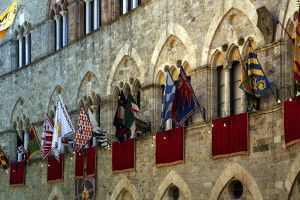 This is a horse race unlike any other, and is all over in 90 seconds. It’s held in the beautiful city of Siena, where the 17 districts compete against each other for the glory. Amazingly a district can still win if the horse loses their jockey during the race, as long as they’re over the finish line first (this has actually happened 23 times since records began). If you have a chance to visit Siena while the Palio is on, you should go – the main square is filled with flags from each district and there is an incredible atmosphere throughout the whole town.
This is a horse race unlike any other, and is all over in 90 seconds. It’s held in the beautiful city of Siena, where the 17 districts compete against each other for the glory. Amazingly a district can still win if the horse loses their jockey during the race, as long as they’re over the finish line first (this has actually happened 23 times since records began). If you have a chance to visit Siena while the Palio is on, you should go – the main square is filled with flags from each district and there is an incredible atmosphere throughout the whole town.
If you want to see just how much the Palio is celebrated in Siena have a look at this…
Here are some of the best things we’ve discovered this week about Italian:
- One of the longest words in Italian is ‘precipitevolissimevolmente’ which means ‘extremely quickly’.
- This Italian tongue twister: ‘Trentatré Trentini entrarono a Trento, tutti e trentatré trotterellando’… which means ‘thirty three Trentonians came into Trento, all thirty three trotting.’
- The word ‘Gelato’ means Italian style ice cream (different to normal ice cream for a number of reasons; firstly it is made with a higher proportion of milk to cream, secondly it has a slower churning process and finally it is served at a slightly warmer temperature than ice cream). Gelato is potentially one of the most important words to know in Italian, as the ice cream cone is an Italian invention and Italy is famous for its Gelato. There’s even an ice cream university in Bologna (Carpigiani Gelato University).
- Italian is a Romance language, meaning it has a Latin origin. Gesture could also be considered important to the Italian language, as messages are often conveyed using hands and facial expressions. When in Italy, you’ll probably hear people saying ‘Ciao Bella!’ to each other as a friendly greeting – but if you don’t want to be too familiar, you may wish to stick to ‘Buongiorno’ (good day) the first time you meet someone.
- The Italian alphabet has twenty-one letters in it. It does not include the letters J, K, W, X and Y; these letters can only be found in foreign words that are common in everyday Italian writing.
- To wish someone good luck in Italian, you should say, ‘In bocca al lupo!’, which translates literally as ‘In the mouth of the wolf’. The correct response to this expression is, ‘Crepi il lupo!’, which means ‘May the wolf die!’
Do you have a favourite Italian word or phrase? We would love to hear from you, so feel free to comment below, tweet us @EuroTalk or write to us on Facebook! And if you’d like to learn some Italian, why not try our free demo, or download our uTalk app to get started.
Alex
10 reasons to visit… Venice
We’ve all seen the Italian city of Venice in the movies, but does it live up to its reputation as one of Europe’s most beautiful and historic cities? Amy says yes; here are her ten reasons to check out Venice for yourself.
1. Boats
I think this has to be a very obvious point, as of course Venice and boats go hand in hand. I was rather taken aback by the beauty of the boats, especially the private taxi boats, as they were all immaculate. If you’re landing when it’s still light, get a private taxi from the airport; it is magical and makes you feel like you’re in a James Bond movie cruising along the Grand Canal.
2. Get lost
Once again I think this is quite a popular theme, but honestly just wander about taking little side streets, because you never quite know what you are going to find, maybe a beautiful street, bridge, shop… or possibly a dead end. As long as you have a map with you when you’re ready to head back, you will be absolutely fine. Once you get to grips with the city it is relatively easy to get around and soon you’ll be wandering off to places without even needing any guidance.
3. Churches
The first world that comes to mind when thinking about the different churches in Venice is WOW. There are a vast number of churches across Venice and the ones we went into were simply stunning. We managed to see several, including St Mary of the Friars, where you can see the famous painting Titian’s Assumption of the Virgin, which caused a lot of commotion when it was first revealed. We also saw San Moisè and Santa Maria della Salute, as well as many more. Each church has a different history so you can never get bored of going into different ones.
4. Bridges
There are over 400 bridges in Venice and rather frequently you stumble upon one that’s just beautiful. They vary from concrete to iron; the concrete ones are traditional Venetian bridges, whereas the iron bridges are Austrian.
5. Islands
If you have the time I would definitely recommend hopping across to the different islands. Murano is the closest island, while Burano and Torcello are a little further away but still very easy to get to. We stopped off at Murano, which is famous for its glass, and we were fortunate enough to see the incredibly talented Glass Masters at work. Next was Burano, known for its lace and its colourful houses; this was so the fishermen could spot their house when they were out at sea. Finally we went to Torcello, which is tiny; there are only 15 homes on the island. Sights on Torcello include the Cattedral di Torcella, which was built in AD 1008, and the Santa Foscafe, which is very impressive to look at from the outside.
6. Beauty
I knew Venice would be beautiful, but what I wasn’t expecting was all of the detail that can be seen everywhere, in the churches, the bridges, and even engravings on some streets to represent different districts. Maybe I had rose tinted glasses on, but whenever I thought I had seen something beautiful I rounded a corner and there was something that topped it. It may sound like a cliché but Venice really does take your breath away.
7. Tour
This is an absolute must, because otherwise you can walk past something and have no idea you have passed a major piece of history. The tour means you really get to know Venice and learn about its history and culture, I can’t even begin to describe how much I learnt about the city and how relieved I was that we did a tour. Without it you could be standing in the square where Shakespeare based The Merchant of Venice and have no idea.
8. History
I can honestly say that I had no idea about the extensive history behind Venice, from the several plagues they suffered, to the different Dukes in power and of course Napoleon taking over the city. You definitely get a better feel for the city once you know more about its history, as well as starting to notice different things yourself when walking around, like the different types of bridges I mentioned earlier, or how the Austrians had to have their own cafés as they were not welcome anywhere else. I would read a little about the city before you go, just so you know a little about the Venetians’ background.
9. Food, Drink and Ice Cream
In Italy you expect great pizza and pasta; however Venice is very much based around seafood, although we also discovered an incredible steak restaurant called Vini Da Artur where we had the best steak we have ever eaten. Of course we had pasta and pizza too, but there is really something for everyone. For drinks, I recommend the Hilton Skyline Rooftop Bar for views of Venice and of course Harry’s bar, which originally opened in 1931 and was where the famous Bellini was invented. It is expensive, but just go for one Bellini to say you’ve experienced Harry’s bar, because the atmosphere in there is fantastic. Finally, ice cream was a must for us over the few days we were in Venice, due to it being very hot. There is a different ice cream shop on all of the busy streets, and they do not disappoint. Because you have to have at least one gelato while you’re in Venice, right?
10. St Mark’s Square
We’ve seen it in lots of films and pictures, but you can’t beat going and seeing it for yourself. Stepping into the square, the first thing you notice is how big it actually is. The main attraction – the church – is simply beautiful; the engravings all across the church and the different colours used are stunning. Going inside the church is a must, and you can pay €2 to go to the back of the church. Do it, you’ll see why. All across the square there are intricate engravings in the marble and different statues everywhere. I don’t want to spoil any surprises for anyone wanting to learn the history of the square, you have to go and experience it – and if you’re going with someone special, go at night too as it’s very romantic.
My only warning about Venice is that you do get harassed to buy a selfie stick or to feed the pigeons, so be prepared to say no!
And of course, don’t forget to download uTalk before you leave; even if you don’t have time to learn some Italian in advance, it’s a really useful app to have on your phone when you’re searching for the right word – we used it a lot!
Have you ever been to Venice? What did you think?
Amy
#giovedìgelato
As you’ll know if you saw my earlier post about Italian habits, I have just come back from living in Rome for four months as part of a compulsory year abroad for my university degree (a.k.a. second gap year). Before departing for adventure no.2 of the year, I was excited to see old stuff, learn some crazy hand gestures, and most importantly, eat well. I soon realised that all of the items on my checklist would be fulfilled the moment I set foot out of my front door every single day of my stay.
As ‘old stuff’ goes, I’d say my favourite has to be the Column of Marcus Aurelius at Piazza Colonna, which stands part way down the Via del Corso that runs from Piazza del Popolo to Piazza Venezia and the gigantic Vittoriano monument. The column towers majestically above shoppers and tourists, who hardly stop to marvel at the intricate story told by the ascending marble figures.
After only a short while in Rome, I came to the realisation that it is in fact impossible to express oneself without one’s hands. Well, express oneself properly anyway. No ‘ma che?’ (an expression of confusion/outrage/misunderstanding/shock) goes without a frown and a double-handed finger-grouped wrist shake, and joy does not exist without at least one arm raised in the air for celebration. These are a passionate people, and they aren’t shy of showing you exactly how they feel.
Now food. I honestly can’t express how much I miss fairly-priced, handmade, loaded plates of pasta, and pizza by the rectangular slice topped with every cut of ham and cheese under the sun. However, it is with gelato that my heart lies, and it’s yearned for it ever since my return. For 18 weeks I undertook an Instagram project entitled #giovedìgelato, trying out new flavours, gelaterie, and selfie angles every Thursday. And it is with you that I would like to share my top three gelaterie in Rome (and the flavours I chose when I was there).
La Romana, 60 Via XX Settembre
I must have been to this gelateria every week I had guests, or if one of my friends had guests, or if I was passing by on my way home, or if it was hot… any excuse really. They offer you white or dark melted chocolate in the bottom of your cone that comes from a free flowing tap, and a choice of four flavours of cream on top of your piled-high gelato. Flavours include ‘biscotto della nonna’, ‘crema dal 1947’ and ‘zabaione come una volta’, inviting you – and all the other 30 people in the queue – to taste the family history of the place. All this for only €2.50. Why did I ever leave?
My #giovedìgelato flavours: ricotta with caramelised figs, yogurt with honey and hazelnut, dark gianduja chocolate in the bottom of the cone, and zabaione cream on top.
Fatamorgana, 9 Via Lago di Lesina
There are several Fatamorgana around the city, but I like this one by Villa Ada in particular, because it makes the journey into a pilgrimage, and the gelato just that little bit more well-deserved. Every time I went (again, it was a relatively frequent occurrence), there were hoards of children with mothers, fathers and grandparents, clambering over each other in an orderly Italian fashion, somewhere between patient and not so, waiting for their number to be called. With over 70 different flavours, I was secretly pleased I had a little while to wait, otherwise I’d never have been able to make a decision: wasabi chocolate, rice and vanilla, and all of the traditional favourites in between. There’s even a sweet little park just opposite where you can enjoy your exotic choices!
My #giovedìgelato flavours: blackberry, ginger with honey and lemon, and three-spiced chocolate chip. No cream this time.
Come il Latte, 24/26 Via Silvio Spaventa
This little gem is just round the corner from La Romana, and although not quite as busy, it is equally worth a visit. Instead of chocolate in the cone, they dip a decorative waffle in it, so that the chocolate dribbles over your gelato. The choice of flavours is not extensive, but changes with availability of ingredients, which adds an element of excitement to the experience (if it isn’t your first time), and underlines their artisan quality.
My #giovedìgelato flavours: melon, salted caramel with Himalayan rose, and a waffle dipped in dark chocolate.
These gelaterie are all slightly out of town, away from the hustle and bustle of the tourist centres. For more central options try:
nr. Trevi Fountain. San Crispino, 42 Via della Panetteria
nr. Circo Massimo. Il Gelato di Claudio Torce, 59 Viale Aventino
nr. Vatican City. Old Bridge Gelateria, 5 Via Bastioni di Michelangelo
Buon appetito!
Lucy
Che dice la nostra cultura quotidiana di noi?
Today we’re excited to share our first ever bilingual post, written by Lucy, who’s just returned from four months in Rome as part of her university studies. In this post, she talks about a few typical Italian habits she noticed during her time in the city and some of the (slightly surprising) questions she had to answer about British culture.
Don’t speak Italian? There’s an English translation below. And if you’d like to join the conversation, you can do so in the comments or on Twitter – see the end of the post for details.
Benché esistano delle centinaia di diverse abitudini italiane, dal nord al sud, dalle montagne alle coste, almeno si trova una percettibile concordanza di “modi di fare” di base che abbraccia il paese: si mangia la pasta ogni giorno, si offre l’opinione se richiesto o non, e non si telefona mai durante l’ora di pranzo (entro le 1300 e le 1500). Non essendo italiana me stessa, trovavo un po’ strano queste regole seguite persino dai giovani come se fossero ordinate dal Papa. Era solo quando mi sono resa conto che sono imposte invece dalle matriarche che iniziavo a capire le sue importanza. C’è una convivialità e un autentico rispetto per il comportamento che insieme danno un metodo alla follia.
Cercavo di integrarmi bene e cordialmente in queste situazioni, e mi piaceva molto imparare questi “si fa” e “non si fa”. Gradualmente mi abituavo a tenere lo sguardo durante il brindisi, a rivolgermi ai vecchi con “Lei” e non “tu”, e di avere pazienza quando facendo una fila perché non si sa mai quanto lungo sarebbe.
Una delle gioie dell’anno Erasmus e che s’incontra delle persone non solo da diversi paesi ma di varie origini, e si tocca di spiegare le sue proprie radici. Qualche volta è più difficile che abbia mai pensato. Vi lascio una manciata di domande che mi capitavo di rispondere durante le 4 mesi che ho passato in Italia:
Perché gli inglesi mettono la moquette dappertutto nelle case, e poi mettono sopra i tappetti?
Questo mi ha sorpreso perché mi chiedevo quasi ogni giorno il ragionamento dietro la mancanza della moquette nell’appartamento che stavo affittando. Storicamente indovino che fu una mostra di stravaganza perché gli sconti per pulirla dovettero essere esorbitanti. Potrebbe essere anche per aggiungere un po’ di calore nelle stanze.
Perché non apprezzate il vino invece di berlo troppo a causa dei giochi di bevanda?
Sono consapevole della riputazione che noi inglesi abbiamo per l’abuso dell’alcool, e a dire la verità, mi vergogna di questo nostro status mondiale. Pero, difendo questa cultura solo un’iota per porre che almeno non abbiamo paura di essere scemi, e questa propensità gli italiani si manca.
E la pioggia…?
Gli italiani che incontro sembrano di avere una vera inquietudine per la mia salute quando imparano che piove più di una volta alla settimana in Gran Bretagna, anche durante l’estate. Ho anche qualche amico italiano che ha sinceramente basato le scelte di università sul clima. Quando si viene da un paese dove il sole brilla nell’estate e la neve cade nell’inverno, scommetto che sarebbe difficile immaginare qualsiasi altra realtà, ancora meno la timorosa pioggia!
Alla fine del mio soggiorno in Italia, avevo la sicurezza di dare direzioni a una taxista con attenzione risoluta, e di rifiutare con cortesia le proposizioni di una vecchia sull’autobus di una cena con la sua nipote (chi tra l’altro sta studiando per diventare medico). Pero, al momento in cui qualcuno mi dà un pezzo di frutta, non sarò mai in grado di mangiarla con le posate, mi dispiace. Certe consuetudini naturalmente resteranno per sempre entro il paese, ma vi consiglio, ansi vi sfido di immergetevi nella cultura italiana e di imparare qualche maniera nuova – vi prometto che vi farà sorridere!
Avete scoperto un’abitudine intrinsecamente italiana che vi è piaciuto mentre stavate in Italia? Condividerlo con noi, lasciando un commento, oppure su Twitter @EuroTalk #abitudineitaliana
What does our everyday culture say about us?
Although there are hundreds of Italian mannerisms, from north to south, whether in the mountains or at the coast, there is a distinguishable way of doing things that brings the country together: they eat pasta every day, they offer their opinion whether asked for or not, and they never phone anyone at lunchtime (1pm-3pm). Not being Italian myself, I found these rules, followed by young and old alike as if handed down by the Pope, a little difficult at first. It was only when I realised that they were actually imposed by the head of the family (the matriarch) that I began to understand their importance. This culture of conviviality, backed by a genuine respect for courtesy, offers a method to the madness.
I tried my best to integrate myself in these situations, and I really enjoyed learning the “do’s” and “don’ts”. Gradually I got used to looking someone sternly in the eye whilst clinking glasses for a toast, to using the third person singular when addressing someone older than me, and to keeping my patience when queuing for anything, because you can never know how long you’ll be waiting.
One of the many joys of an Erasmus year is that you meet people who are not only from different countries but varied backgrounds, which means you are also tasked with explaining the reason to your rhyme. This is often harder than you’d have ever thought. Here are a few questions that I had to reply to during my four months in Italy:
Why do English people put carpet everywhere in the house, and then put rugs on top?
This question really surprised me because I’d been wondering why there wasn’t any carpet to be seen in the apartment I was living in. I guess that historically, carpet was a demonstration of extravagance because the cost of cleaning them would have been extortionate. It could also be because carpet adds warmth to a room.
Why don’t English people appreciate wine instead of drinking too much of it (for example in drinking games)?
I’m aware of the reputation that us Brits have for abusing alcohol and to tell you the truth, our world-renowned status is embarrassing. However, I’ll defend our drinking culture just an iota by proffering that at least we’re not afraid of looking a bit silly every once in a while, which is a propensity that Italians seem to lack.
And what about the rain…?
Italians that I have met seem genuinely worried for my health when they learn that it often rains more than once a week in the UK, even in the summer. I have a couple of Italian friends who have even based their university choices on the weather. I guess when you come from a country where the sun shines in the summer and the snow falls in the winter, it’s would be pretty difficult to imagine anything different, much less the infamous rain!
At the end of my stay in Italy, I had acquired the confidence to give firm directions to a taxi driver, and to politely decline offers from old ladies on the bus to have their grandson (who as it happens studies medicine) take me out to dinner. However, I’m afraid to say that if someone were to hand me a piece of fruit, I still wouldn’t ever be able to eat it with a knife and fork. Some customs will obviously stay forever within a country, but I recommend or even challenge you to immerse yourself in Italian culture and to learn a new quirk – I promise it’ll make you smile!
Have you discovered any fun intrinsically Italian habits? Share them with us by leaving a comment, or on Twitter @EuroTalk #abitudineitaliana
Lucy



